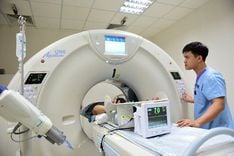This is an automatically translated article.
Dose-modulated radiation therapy (IMRT) is an advanced radiotherapy technique that increases the ability to kill tumors while reducing the side effects of radiation therapy, improving the quality of life for patients.
1.What is dose-modulated radiation therapy (IMRT)? Scientific name: Dose-modulated radiation therapy (IMRT) Preliminary technical description: High-precision radiotherapy technique by computer-controlled linear accelerators to deliver precise radiation doses to malignancies or specific areas within the tumor. IMRT allows for more precise and consistent radiation dose than 2D, 3D and 3D-CRT radiotherapy techniques. Furthermore, IMRT uses multiple beams to deliver a high dose to the target tissue with a rapidly decreasing dose outside the target tissue, thereby minimizing the dose received from adjacent normal tissues.
2.What disease is this technique used to treat? Cervical cancer Liver cancer 3.Indications and contraindications Indications:
Brain tumor Head and neck cancer Lung cancer Esophageal cancer Prostate cancer Soft tissue cancer Cancer in children. Contraindications:
Pregnant and lactating women without a doctor's prescription

Xạ trị điều biến liều sử dụng máy gia tốc tuyến tính để đưa liều bức xạ chính xác tới khối u hoặc thể tích cần điều trị.
4.Advantages and disadvantages of the technique Advantages:
Dose-modulated radiation therapy has obvious advantages over conventional radiotherapy in the treatment of many types of cancer, especially when the treatment volume is large and the tumor is large. located in areas with many important organs such as head and neck, mediastinum and pelvis. Cons:
Patients may appear some side effects such as: fatigue, loss of appetite, nausea, dermatitis, mucositis, digestive disorders, urinary disorders. 5. Procedure Step 1: Doctor consults to determine treatment protocol Step 2: Immobilize patient, simulate CT scan. The simulated CT image of the patient is transferred to the planning computer system. Step 3: The doctor outlines the treatment volume and healthy organs on the simulated CT image, can refer to the MRI or PET/CT images when necessary. Step 4: Physical engineer and doctor together discuss and plan treatment for the patient. The number of projection fields, projection angle, MLC movement speed are automatically optimized by the computer by reverse planning. Step 5: The physical engineer checks the pre-treatment plan. Step 6. Set the patient position on the treatment table. Step 7: Take a digital X-ray before each treatment (radiotherapy under image guidance). Compare the electronic portal image (EPI) of the patient before treatment with the digital reconstructed radiograph (DRR) image of the treatment plan to ensure the correct position. of the patient when the treatment was exactly as positional in the planning simulation with an allowable error of < 3 mm for head and neck tumors and < 5 mm for thoracic-abdomen-pelvic tumors. Step 8: Radiation treatment to the patient. During the treatment, the technician will monitor the patient through the camera and the treatment parameters on the computer screen During the treatment, the patient will not feel any pain or any discomfort. The duration of each dose-modulated radiotherapy session is 15-20 minutes. Typically, a course of IMRT radiation therapy lasts from 25 to 35 days, depending on the type of disease requiring radiation therapy. Before each treatment, after the patient is fixed in the treatment position by the radiotherapy technicians on the treatment table, images of the treatment posture are taken by pre-treatment posture inspection systems, If the position is completely correct, then the treatment will be performed immediately. 6.Normal expression after performing the technique During radiotherapy, there will be some side effects that make the patient tired, nausea, skin inflammation, digestive disorders, urinary disorders.... Most of them These side effects were all mild and reversible after 1 to 2 weeks of treatment.
7.When are the following manifestations of technique abnormal and need immediate re-examination? Anaphylaxis during or after radiation therapy
8.Machine/equipment needed to perform this technique Truebeam NDS120HD V2.7 Accelerated Radiation Therapy Machine 9.Things to keep in mind when performing this technique Patients should have a clinical examination and a doctor's explanation of the reasons for radiation therapy and full instructions before radiation therapy.
Please dial HOTLINE for more information or register for an appointment HERE. Download MyVinmec app to make appointments faster and to manage your bookings easily.













